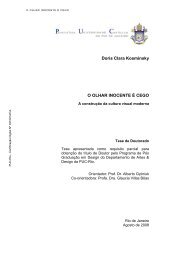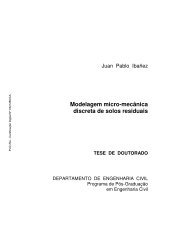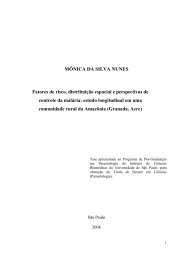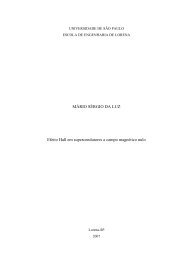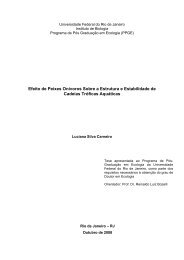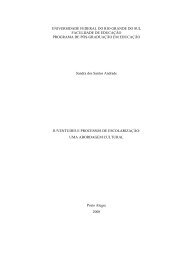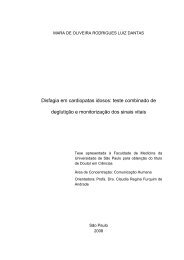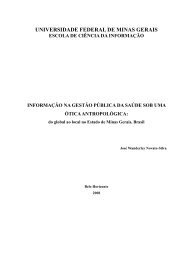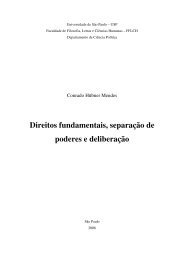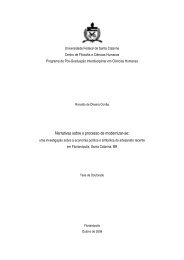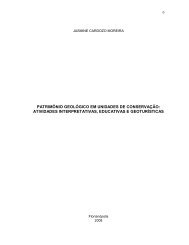You also want an ePaper? Increase the reach of your titles
YUMPU automatically turns print PDFs into web optimized ePapers that Google loves.
1046 D.A.R. Magalhães et al. / Molecular Immunology 42 (2005) 1043–1048Fig. 2. Clustering samples of each day of thymus gestation of the (Balbc× C57Bl/6) F 1 hybrid mice considering the raw normalized expression dataof the 1,261 <strong>gene</strong>s. (www.rge.fmrp.usp.br/passos/TRBV81/cluster1261).ages p.c., showed that there is variability in the patternsof <strong>gene</strong> expression of the thymus within mice for eachday of gestation. This variability caused shuffling in theclustering of the RNA samples (cDNA probes) of fetuses(Fig. 2) (www.rge.fmrp.usp.br/passos/TRV81/cluster1261).We used the approach of clustering the significant <strong>gene</strong>sproposed by the SAM program, i.e. only those induced orrepressed <strong>gene</strong>s whose variability was statistically significant.This approach successfully distinguished the samplesof thymi according to days of gestation (Fig. 3)(www.rge.fmrp.usp.br/passos/TRBV81/reclustering/SAM).3.3. Genes differentially expressed in the developingthymusTo identify significant changes in <strong>gene</strong> expression duringfetal development of the thymus, we compared the stage whenthe onset of TRBV8.1 recombination occurs, at 14 days ofgestation, with those observed on the subsequent days (14versus 15, 14 versus 16 and 14 versus 17 days p.c.). We useda scatter plot of the observed relative difference d(i) versusthe expected relative difference d E (i) as shown by the SAMprogram.Most of the 1,261 <strong>gene</strong>s tested presented d(i) ∼ = d E (i), i.e.their expression pattern did not change; however, some <strong>gene</strong>swere significantly induced or repressed during thymus development(Table 1)(www.rge.fmrp.usp.br/passos/TRBV81/SAM/table1).Fig. 3. Reclustering samples of each day of thymus gestation of (Balbc× C57Bl/6) F 1 hybrid mice considering only the significant expressed<strong>gene</strong>s reported by the SAM program. (a) 14 vs. 15, (b) 14 vs. 16 and (c) 14 vs.17 days of gestation. (www.rge.fmrp.usp.br/passos/TRBV81/reclustering/SAM).Table 1Number of <strong>gene</strong>s differentially expressed during thymus development of(Balb-c × C57Bl/6) F 1 hybrid mice as reported by the SAM program aThymus development(in days p.c.)Significant <strong>gene</strong>sInducedRepressedFDR14–15 31 73 4814–16 16 47 2214–17 18 21 64a Complete file of <strong>gene</strong> names available online (www.rge.fmrp.usp.br/passos/TRBV81/SAM/table1), FDR = false discovery rate (median).4. DiscussionThe aim of the present study was to perform a comparativelarge-scale <strong>gene</strong> expression analysis of thymocyte maturationduring ontogeny of the thymus of (Balb-c × C57Bl/6) F 1 hybridmice to gain new insights into the modulation of <strong>gene</strong>transcriptions which could be correlated with T-cell maturation.In previous observations, we described the different timingof T-cell maturation first by means of detection of theonset of the T-cell receptor TRA and TRB V(D)J recombinationsin Balb-c, C57Bl/6 and CBA/J strains (Junta and Passos,1998; Mace<strong>do</strong> et al., 1999) and second by showing that severalimmune system-related <strong>gene</strong>s such as interleukins andMHC displayed a differential expression pattern among thesestrains during thymus ontogeny (Espanhol et al., 2003).T-cell differentiation and all developmental stages withinthe thymus are distinguishable by the expression of CD cellsurfacemarker combination. The V(D)J recombination of theTRA/TRB and TRG/TRD segments is a central phenomenondefining the T-cell fate, which is mediated by recombinasecomplex from RAG-1 and RAG-2 <strong>gene</strong>s and modulated byseveral other <strong>gene</strong> products (Muegge et al., 1993; Sollof etal., 1997).In the present study we showed that the emergence of theTRBV8.1 rearrangement during fetal development of the heterozygous(Balb-c × C57Bl/6) F 1 mouse thymus occurs onday 14 p.c., similar to the parental strain C57Bl/6 (Espanholet al., 2003). This suggest a participation of the <strong>gene</strong>tic backgroun<strong>do</strong>f the C57Bl/6 strain in the control of T-cell maturation.Despite the relevance of transgenic and knock-outmice to immunological research, the classical inbred nonmanipulatedmouse strains constitute a model-system forstudies on the effects of different <strong>gene</strong>tic backgrounds onthe modulation of T-cell maturation. In recent years, ourgroup has pursued this approach with the classical inbredstrains (Espanhol et al., 2003, 2004; Junta and Passos, 1998;Mace<strong>do</strong> et al., 1999) and in the present study we are reportingthe first large-scale hybridization signatures of the thymus ofheterozygous mice resulted from the fusion of two inbreddifferent <strong>gene</strong>tic backgrounds.Two approaches were used to analyze the large-scale <strong>gene</strong>expression profile of the developing thymus of F 1 hybrid



